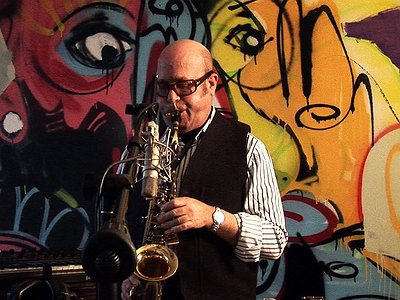Part 2
The relationship between music and other forms of art – painting, video art and cinema most importantly - has become increasingly important. How do you see this relationship yourself and in how far, do you feel, does music relate to other senses than hearing alone?
I am quite immersed in the juncture between music and the visual and time-based arts: this is, so to speak, where I live. I have a life-long collaboration with video artist Kit Fitzgerald, my creative partner and my wife. The community I live in consists of artists of all media: these are my friends and folks I socialize with, and when I was first starting out, the NY art world helped to serve as an incubator for my work. Additionally, I am a professor at Bloomfield College, in the division of Creative Arts and Technology, where a multidisciplinary and collaborative curriculum is stressed
For me, the connection with time-based arts and music is most direct. I have found that when collaborating on a work of choreography, theatre, or any narrative work, musical parameters, such as density and pacing, are directly impacted. Ideas of story structure, as well as non-narrative structures, have clearly influenced the ways in which I have developed musical ideas.
There seem to be two fundamental tendencies in music today: On the one hand, a move towards complete virtualisation, where tracks and albums are merely released as digital files. And, on the other, an even closer union between music, artwork, packaging and physical presentation. Where do you stand between these poles?
I appreciate the coexistence of the digital world with the physical world. With digital portals, there is the opportunity for music to function as news, with an immediate spontaneity. There is a social power in music that is currently being under-utilized. While much energy is spent in discourse on social media, for better or worse, it would be interesting if this energy could translate more into music, art and advocacy.
But a physical manifestation of the music is useful as a totem - a thing of value, with a physical connection to the listener. It can be as primal as the smell of a virgin vinyl, or balancing a CD in the hand. There will be newer solutions – USB sticks in some form? – but for a certain core audience, that actual physical exchange with an object will signify ownership, and value. This is why merchandise is so important for some artists.
The role of an artist is always subject to change. What's your view on the (e.g. political/social/creative) tasks of artists today and how do you try to meet these goals in your work?
Society is changing at a rapid pace. Change is inevitable, of course, but there needs to be a critical mass consciousness, to ensure that change happens in the right direction and for the right reasons. Social activism is important, and for an artist, this includes being cognizant of what is going on around you. Musicians, artist, DJs, and performers of Earth: we are privileged to get to travel around, meet and talk to new people. One needn’t harangue: artists tend to be thoughtful individuals, and have the power to communicate difficult ideas. As citizens, it is important to be aware of the shifting social contract and power balance, and to speak out for social and environmental justice.
But some work in abstract forms, or create fictional narratives, and in order to find truth, an artist must enter a special self-selected world – an artificial bubble - which may, or may not, manifest the actual socio-political, or emotional, state of the artist. Only then can one achieve true artistic freedom and honesty.
Music-sharing sites and -blogs as well as a flood of releases in general are presenting both listeners and artists with challenging questions. What's your view on the value of music today? In what way does the abundance of music change our perception of it?
Music has become less homogenized. There are many more styles, genres and sub-genres. There might be more ways for an artist to introduce their music, but many are not so obvious; it helps if one is creative and entrepreneurial. The definition of achievement – and the different levels thereof - has shifted. This can be frustrating for the artist, but there is also a democratising aspect to it. In the past, there was a clear professional path to success in the music business: a. write good songs, b. make a demo, c. your demo, plus having a core following, plus luck, lands record deal, d. label promotes (or doesn’t) the record. e. reviews in print media might ensue, radio play may or may not happen.
Today, you can record a track in an all night session on your laptop, upload it to a few key sites, maybe have it picked up by a key DJ or blog or two, and in 24 hours go viral. Or not.
How, would you say, could non-mainstream forms of music reach wider audiences?
Here there is a matter of definition. As soon as a music reaches a wider audience, it inherently becomes mainstream. The audience for a specialty music can grow, or it may remain static, with a core, unshakeable following. Some music isn’t designed for a mass audience. With the breakdown of the record label hegemony, we are finding more specialty and niche music that defies mainstreaming. ‘
One way non-mainstream music reaches the wider audience, however, is when it is associated with a mainstream film or advertisement. Also, music supervisors and curators of “lifestyle” music playlists (restaurants, designer shops, etc.) might help introduce non-mainstream music to the public.
Usually, it is considered that it is the job of the artist to win over an audience. But listening is also an active, rather than just a passive process. How do you see the role of the listener in the musical communication process?
It’s really a spectrum, and depends entirely on the particular music. For some music - more presentational, such as concert music and “art” music – the listener is expected to behave in a certain way, out of consideration for other listeners and the players. The audience sits passively during the performance, with applause allowed at proper times, but generally muted. For other contexts, however, the audience is expected to be active and vocal, such as in dance music, where the music has a specific job to do.
Reaching audiences usually involves reaching out to the press and possibly working with a PR company. What's your perspective on the promo system? In which way do music journalism and PR companies change the way music is perceived by the public?
Promotion and journalism are two different sides of a coin. We are living in a capitalist society, and for those with a product or service to sell, branding is of central importance. One can say this is a necessarily evil, but if music is a product and/or a service, a commercially ambitious music maker needs to pay attention to promotion and branding. At a certain point, this involves engaging professionals. This costs money, however, so there needs to be a revenue stream to warrant this expenditure, and thus, the integrity of the artist is susceptible to compromise.
It is the role of the journalist, however, to cut through all of the extraneous promotional noise and to experience the work on it’s own terms, to listen and to be thoughtful and articulate.






